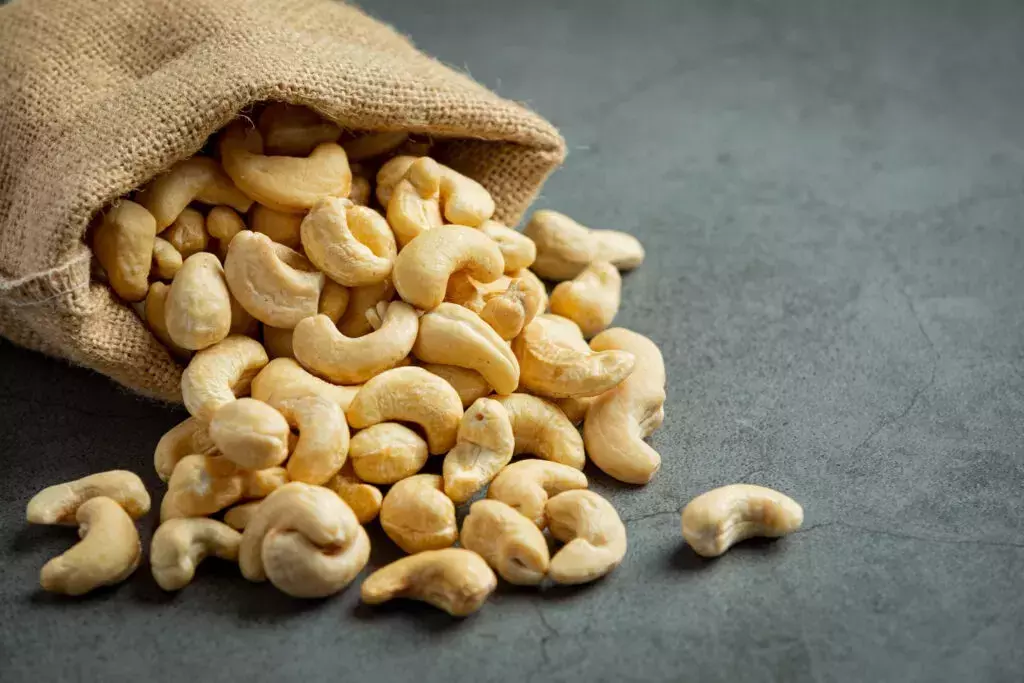On National Cashew Day, trace the nut’s rich history, role in world trade
Cashews are seeds produced by a tropical evergreen tree known as Anacardium occidentale
By Beyniaz Edulji
Hyderabad: National Cashew Day is celebrated on November 23 every year with great enthusiasm to honour one of the most loved and nutritious nuts.
These kidney-shaped nuts are packed with premium taste, rich nutrition and diverse culinary uses.
The versatility of cashews
Cashews are a versatile ingredient, used in both sweet and savoury dishes, from creamy curries and stir-fries to simple snacks and vegan substitutes. Cashews provide a rich, creamy base when blended and a nice crunch when added whole to main courses.
Not a true nut
Cashews are seeds produced by a tropical evergreen tree known as Anacardium occidentale.
The cashew tree produces cashew apples, small red-yellow false fruit with a cashew nut dangling off the base. Although the cashew seed is called a nut, it's not a true nut—true nuts come from fruits with a single seed and a hard shell.
The fruit is not edible, but a very popular alcohol called feni is made from it in Goa.
Native to South America
Cashews were exported from Brazil in the 16th century by the Portuguese, who kept the plant’s native name, caju. Some of today’s major producers of cashews include India, Mozambique, Vietnam and Nigeria.
They are mostly sold deshelled and skinless because the nut’s raw exterior contains anacardic acid, a skin irritant.
The cashew tree, Anacardium occidentale, generally considered native to the northern part of South America, is now found in many tropical areas. The English name ‘cashew’ is derived from the Portuguese name of similar pronunciation, ‘caju’. Cashew originally belongs to Brazil, found well at home in Indian peninsular soils, and benefited the Indian rural economy as a premier crop in commerce.
History of cashew
The tree has easily established itself among men and animals since prehistoric times. Spanish sailors took cashews to Central American countries, and the Portuguese brought the cashew to their territories in the East Indies and Africa.
Cashew came to Goa, Portugal’s main settlement in the East Indies. It is believed that the Portuguese brought the cashew to India between 1563 and 1578.
Geographical location
After India, it was introduced into Southeastern Asia and it arrived in Africa during the second half of the 16th century, first on the east coast and then on the west and lastly in the Islands.
The cashew later spread to Australia and some parts of the North American Continent. Its growth is geographically located between 31' North latitude and 31' South latitude, both as the wild species and under cultivation.
Importance in world trade
Small quantities of cashew kernels were imported into the USA as early as 1905.
World trade started after representatives of the General Food Corporation discovered these nuts during their mission to India in the early 1920s.
Besides regular shipments to the USA, small consignments were also sent to several European countries, particularly to the United Kingdom and the Netherlands. By 1941, the Indian export of cashew kernels had increased to nearly 20,000 tons.
Today, cashews are an important item in world trade, calculated in billions. Cashews are imported in raw form and then marketed in different countries, mostly roasted and salted.
Worldwide, it is most popular as a snack. In recent times, its value as food is gaining importance.
Rich and creamy
Cashews have a mild flavour and creamy, rich texture, but despite their richness, cashews are slightly lower in fat than most other nuts.
Cashews are protein-packed and great for snacking, making butter much like peanut butter, blending to make a vegan milk or adding to stir-fried vegetables and chicken.
Multiple health benefits
They help protect against narrowed arteries
They help you to live longer
They contain antioxidants to help protect against certain diseases
They reduce the risk of heart disease and stroke
They may reduce osteoarthritis symptoms
They may help manage colitis symptoms, promote healthy weight loss, manage blood sugar levels, reduce the risk of stroke, and prevent memory loss
Cashew Curry Recipe
Ingredients
1 tbsp oil
1 onion
5 cloves of garlic
1 inch piece fresh ginger
2 tsp coriander powder
1 tsp turmeric powder
1 tsp chilli powder
½ tomato cut finely
1 cup coconut milk
1 cup vegetable stock
1 cup raw cashews
salt to taste
green coriander for garnish
Instructions
Chop the onion, ginger and garlic finely. Add oil to a large frying pan and add in the chopped onion. Saute onion over medium heat for 5 minutes, stirring often, until onion begins to brown slightly.
Add in the chopped ginger and garlic and stir well. Add tomato.
Then add in the salt, coriander, turmeric, chilli powder, coconut milk and vegetable stock, and stir well.
Add in the cashews and stir well.
Cover the pan and let it simmer over a low flame for 30 minutes. If the liquid evaporates and it is too thick, add a little water or vegetable stock and stir again.
Remove from heat, serve garnished with chopped green coriander.